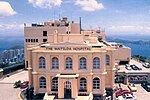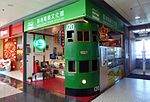Ho Tung Gardens

Ho Tung Gardens, also known by its Cantonese name 'Hiu Kok Yuen', was a villa on the Peak, Hong Kong. It was built by Robert Hotung and his wife Clara in 1927. They referred to it as "The Falls", but it later became known as Ho Tung Gardens. In 2011, it was listed as a Grade I historic building by the Antiquities Advisory Board (AAB). Invoking the relevant section of the Antiquities and Monuments Ordinance for the fourth time in history, it was declared a "proposed historic monument" by the Government of Hong Kong in 2011. Negotiations between the owner and the government to save the mansion failed, and demolition work was completed in October 2013.
Excerpt from the Wikipedia article Ho Tung Gardens (License: CC BY-SA 3.0, Authors, Images).Ho Tung Gardens
Peel Rise, Hong Kong Island The Peak (Central and Western District)
Geographical coordinates (GPS) Address Nearby Places Show on map
Geographical coordinates (GPS)
| Latitude | Longitude |
|---|---|
| N 22.264 ° | E 114.1525 ° |
Address
D座 Block D
Peel Rise 7
Hong Kong Island, The Peak (Central and Western District)
Hong Kong, China
Open on Google Maps











